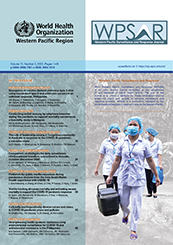Emergence of vaccine-derived poliovirus type 2 after using monovalent type 2 oral poliovirus vaccine in an outbreak response, Philippines
DOI:
https://doi.org/10.5365/wpsar.2022.13.2.904Abstract
Objective: In response to an outbreak of circulating vaccine-derived poliovirus (cVDPV) type 2 in the Philippines in 2019–2020, several rounds of supplementary immunization activities using the monovalent type 2 oral poliovirus vaccine (OPV) were conducted for the first time in the Western Pacific Region. After use of the monovalent vaccine, the emergence of vaccine-derived poliovirus unrelated to the outbreak virus was detected in healthy children and environmental samples. This report describes the detection of this poliovirus in the Philippines after use of the monovalent type 2 OPV for outbreak response.
Methods: We describe the emergence of vaccine-derived poliovirus unrelated to the outbreak detected after supplementary immunization activities using the monovalent type 2 OPV. This analysis included virus characterization, phylogenetic analyses and epidemiological investigations.
Results: Three environmental samples and samples from six healthy children tested positive for the emergent vaccine-derived poliovirus. All isolates differed from the Sabin type 2 reference strain by 6–13 nucleotide changes, and all were detected in the National Capital Region and Region 4, which had conducted supplementary immunization activities.
Discussion: Since the 2016 removal of type 2 strains from the OPV, vaccine-derived poliovirus outbreaks have occurred in communities that are immunologically naive to poliovirus type 2 and in areas with recent use of monovalent OPV. To prevent the emergence and further spread of cVDPV type 2, several interventions could be implemented including optimizing outbreak responses by using the monovalent type 2 OPV, accelerating the availability of the novel type 2 OPV, strengthening routine immunization using inactivated polio vaccine and eventually replacing OPV with inactivated poliovirus vaccine for routine immunization.

